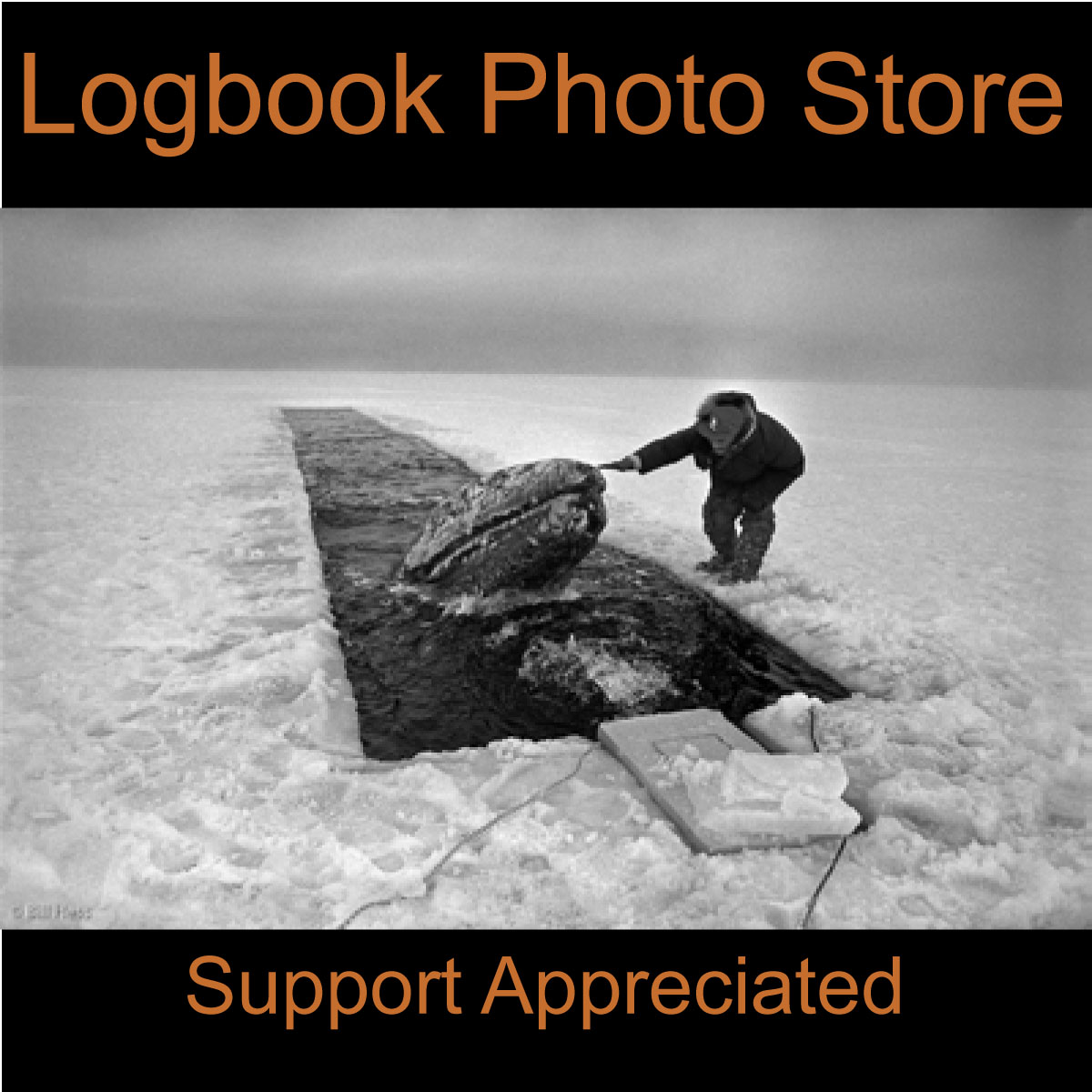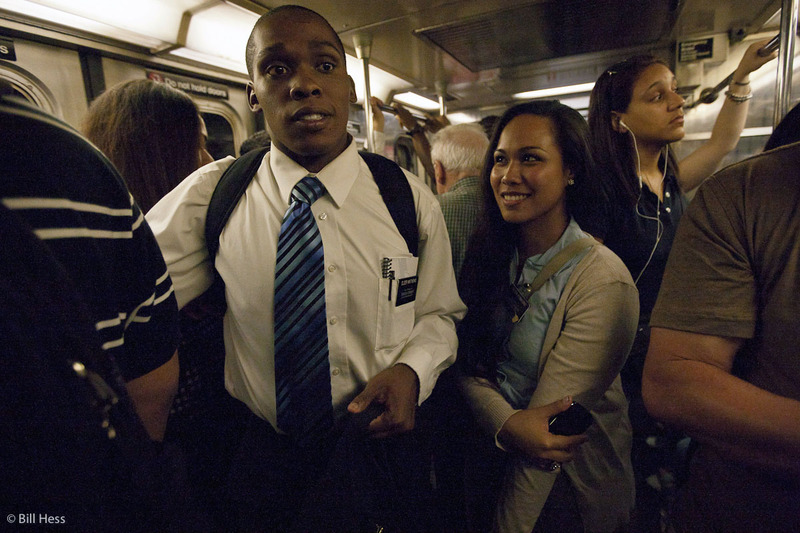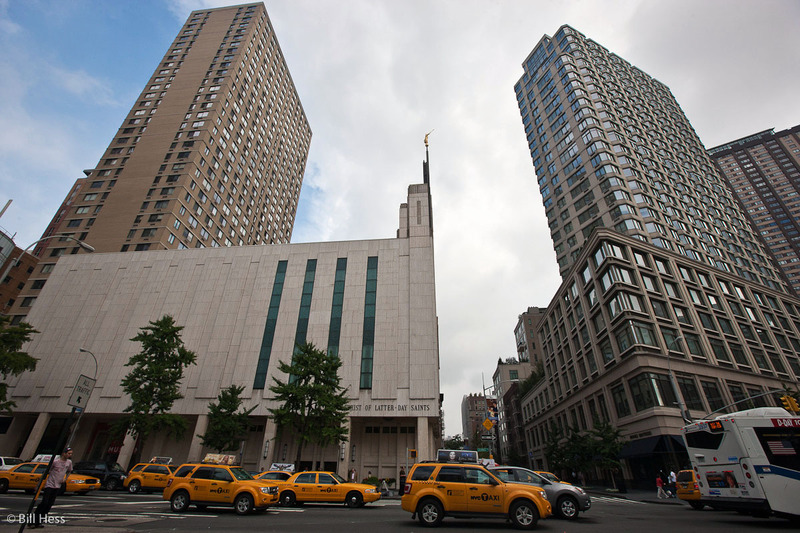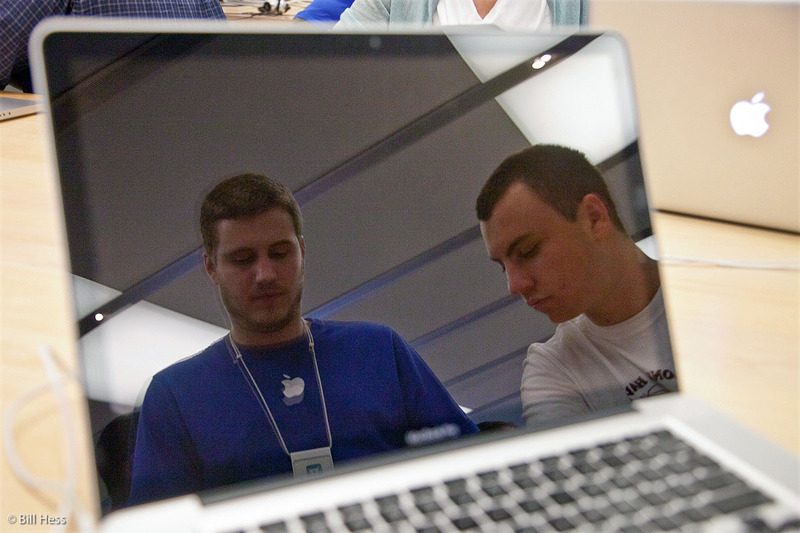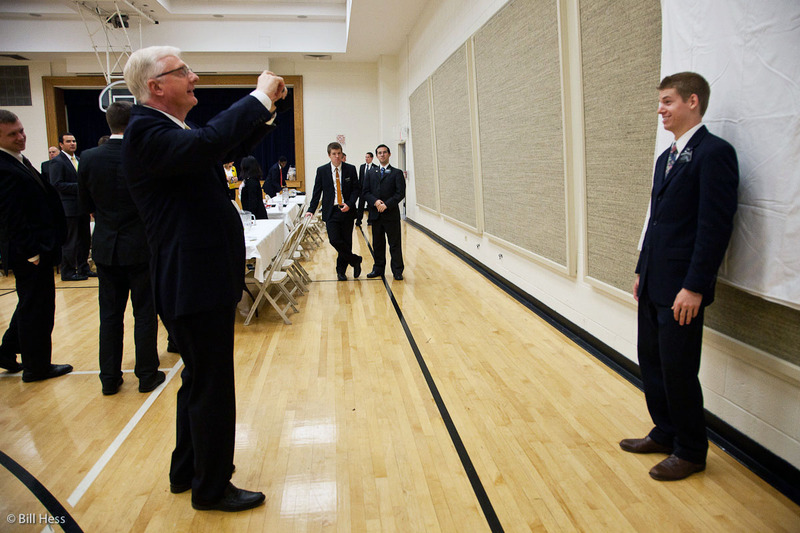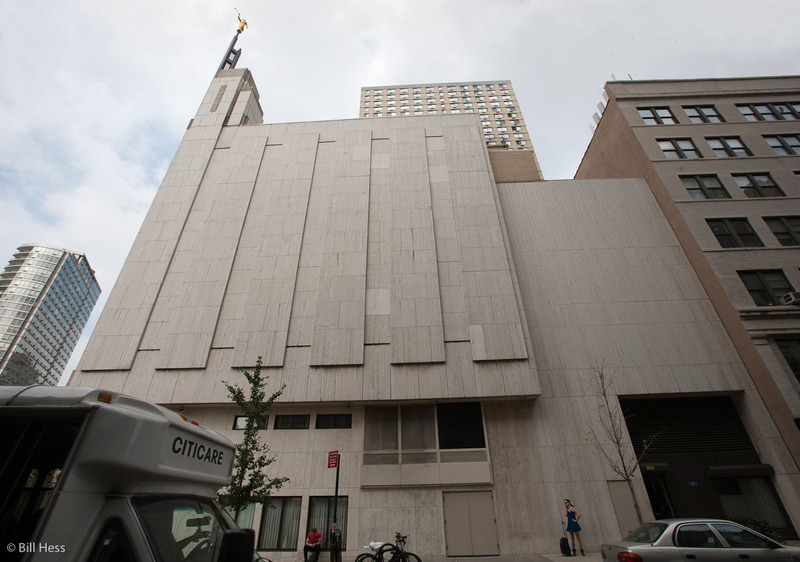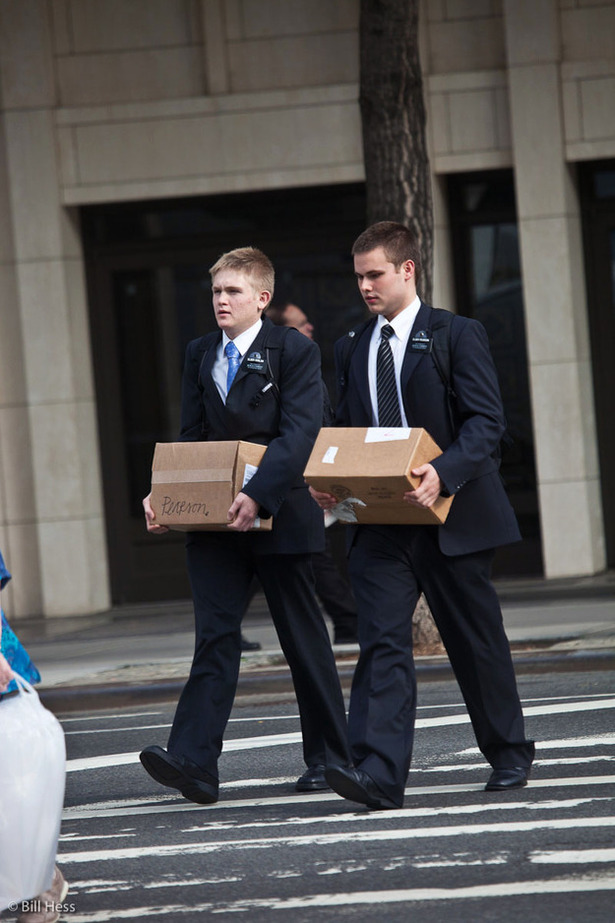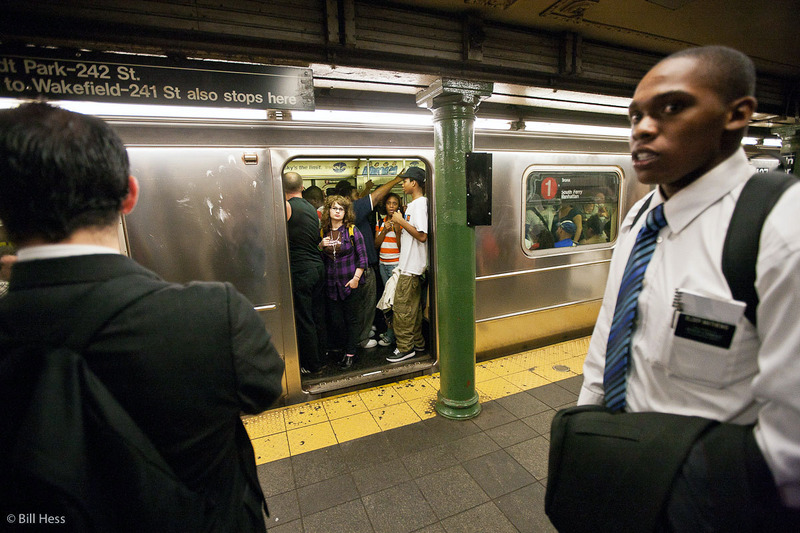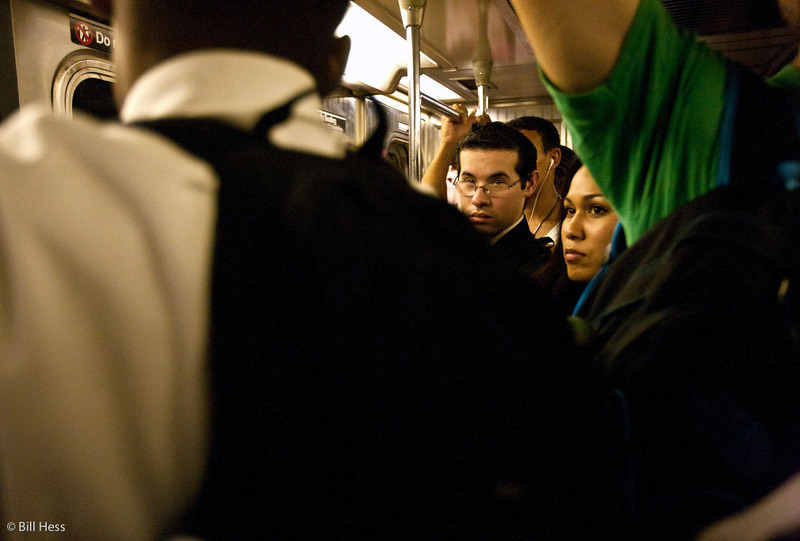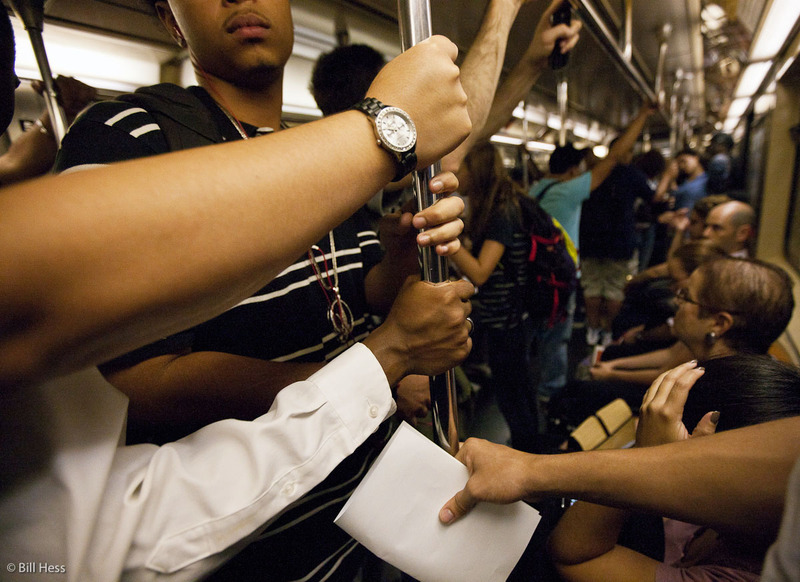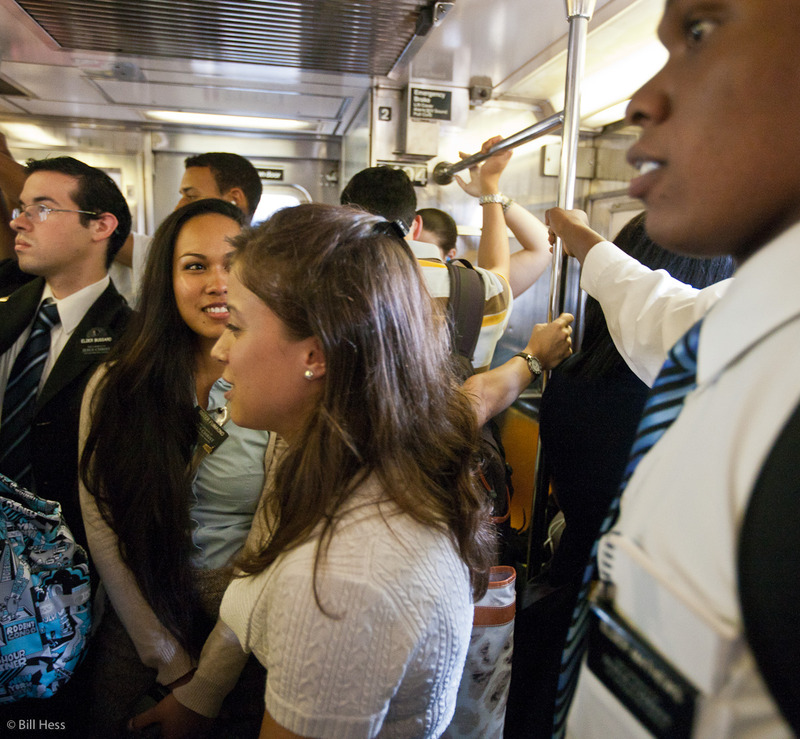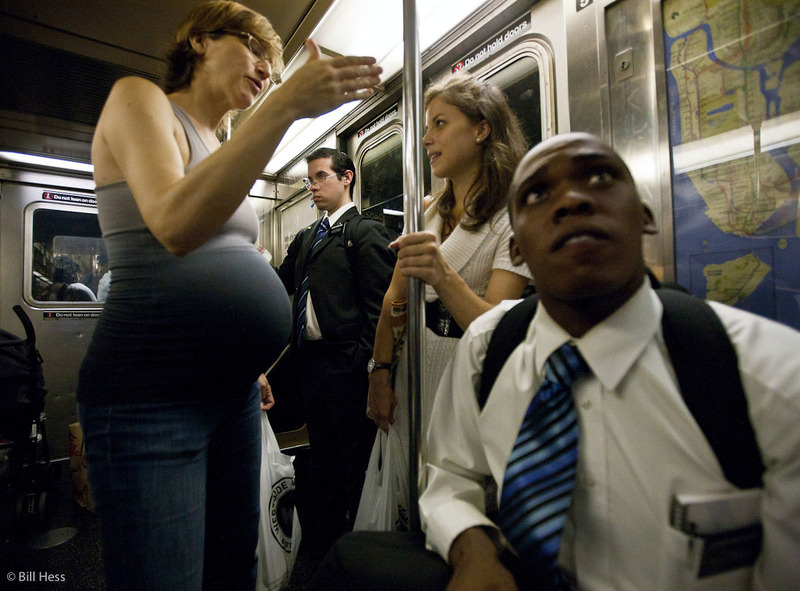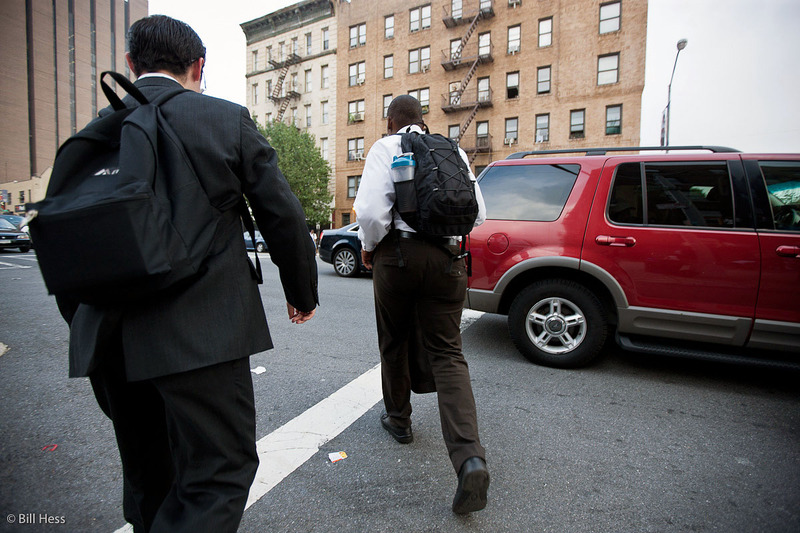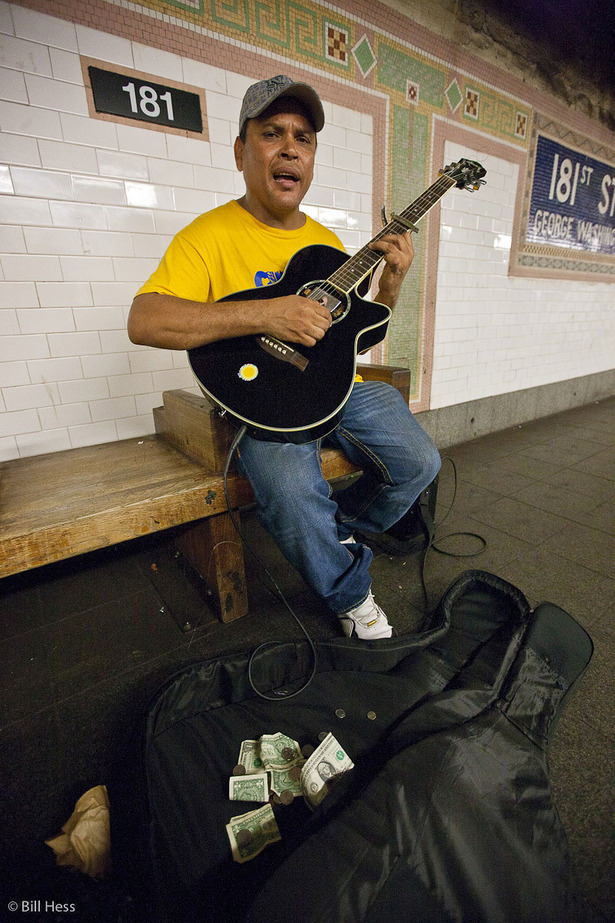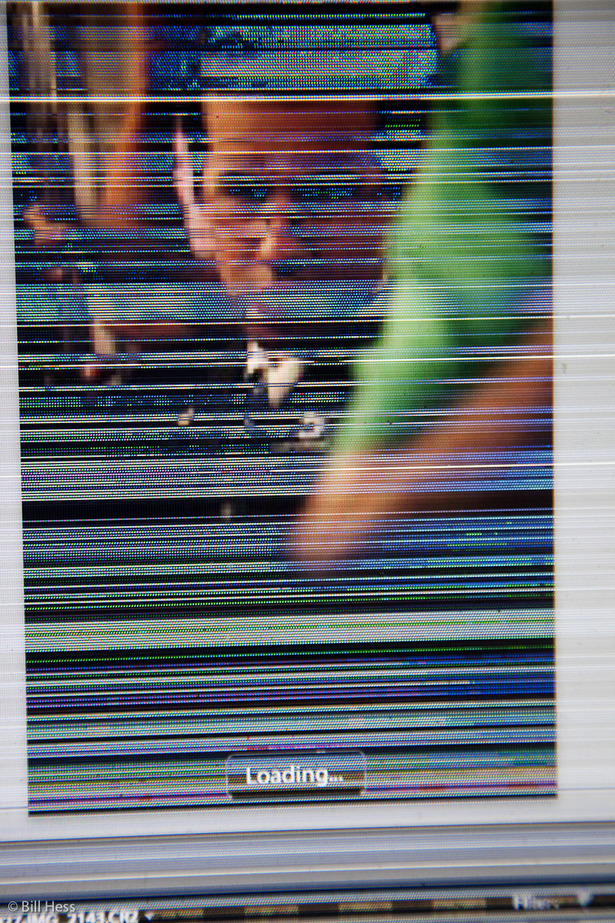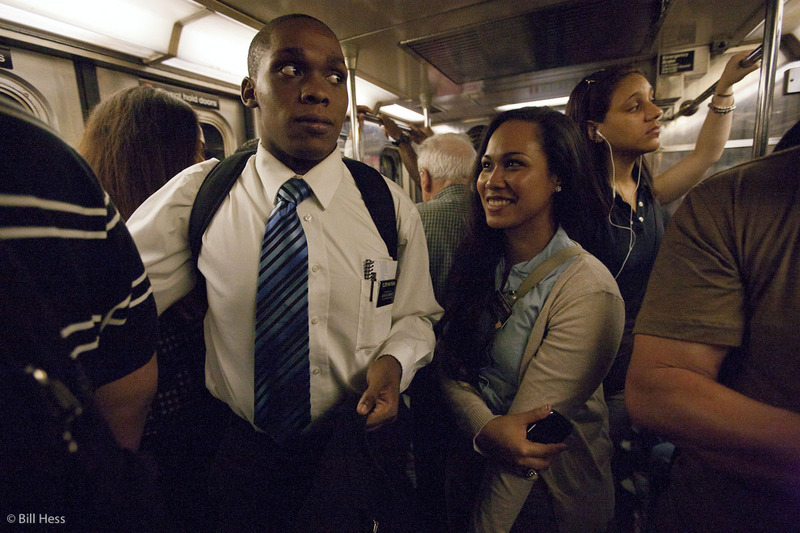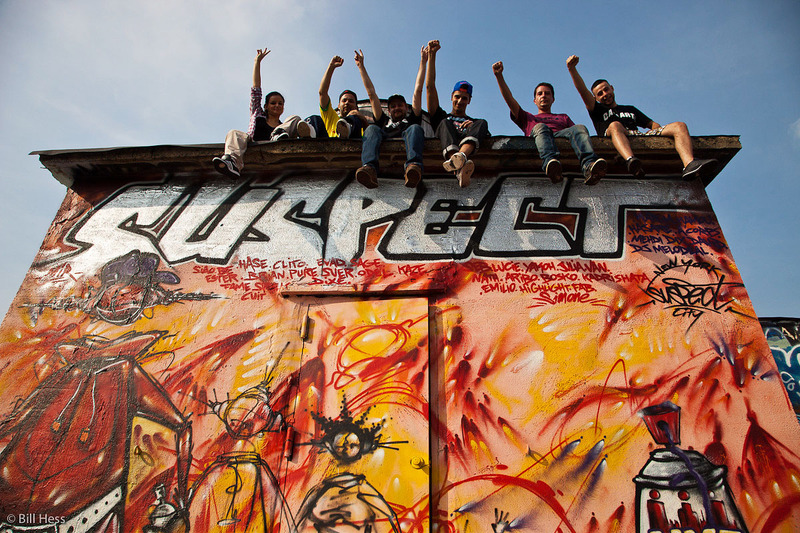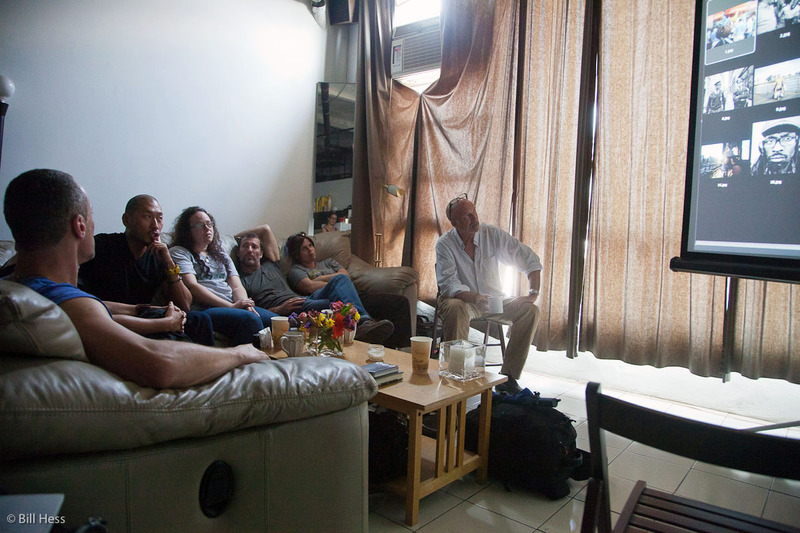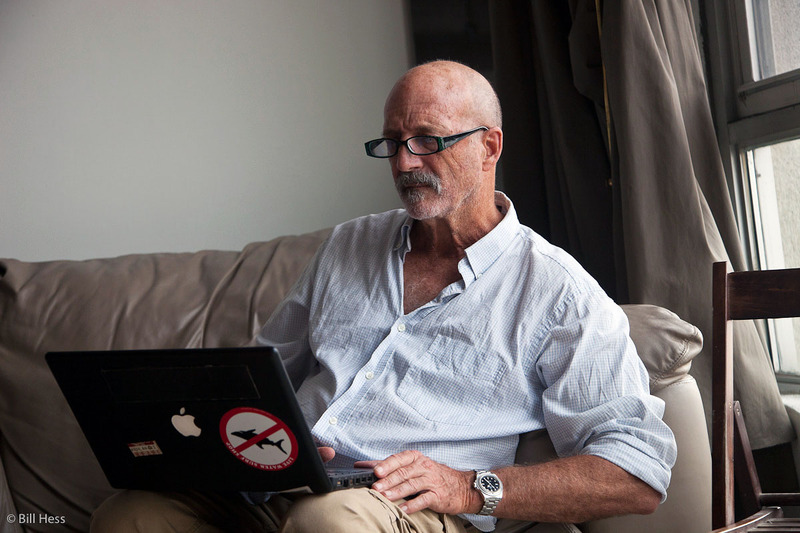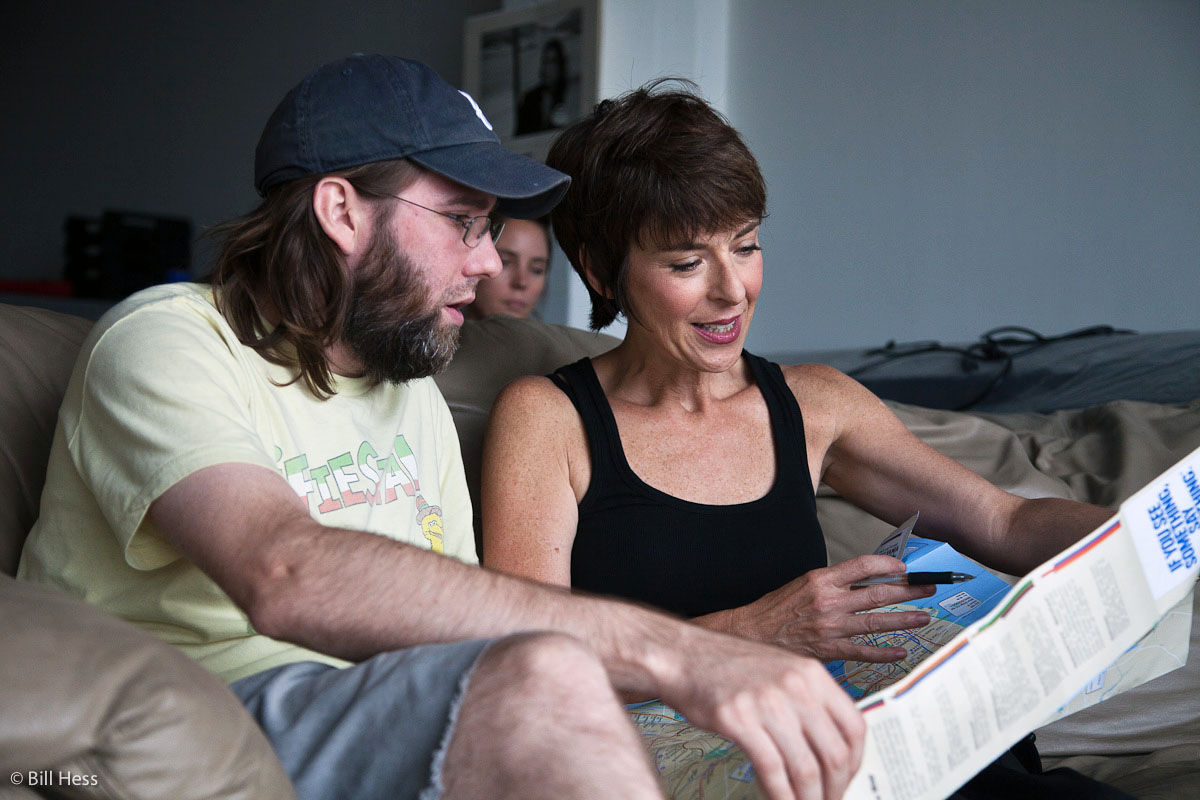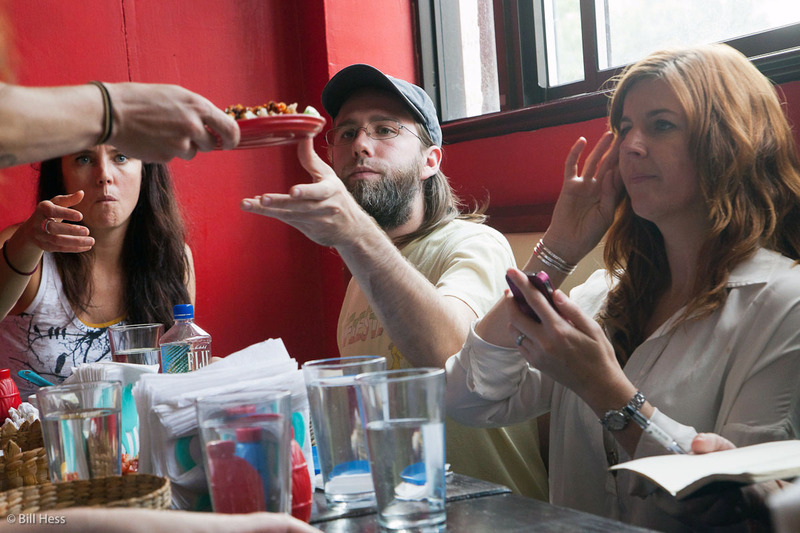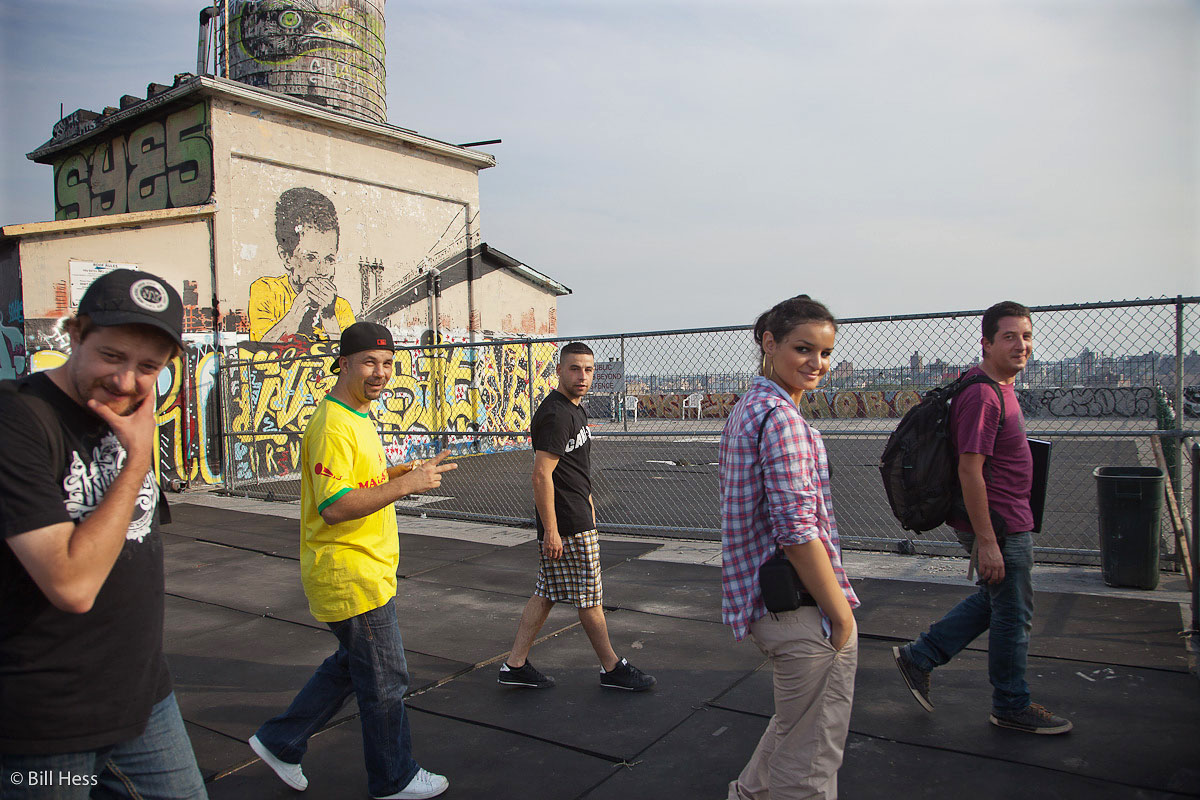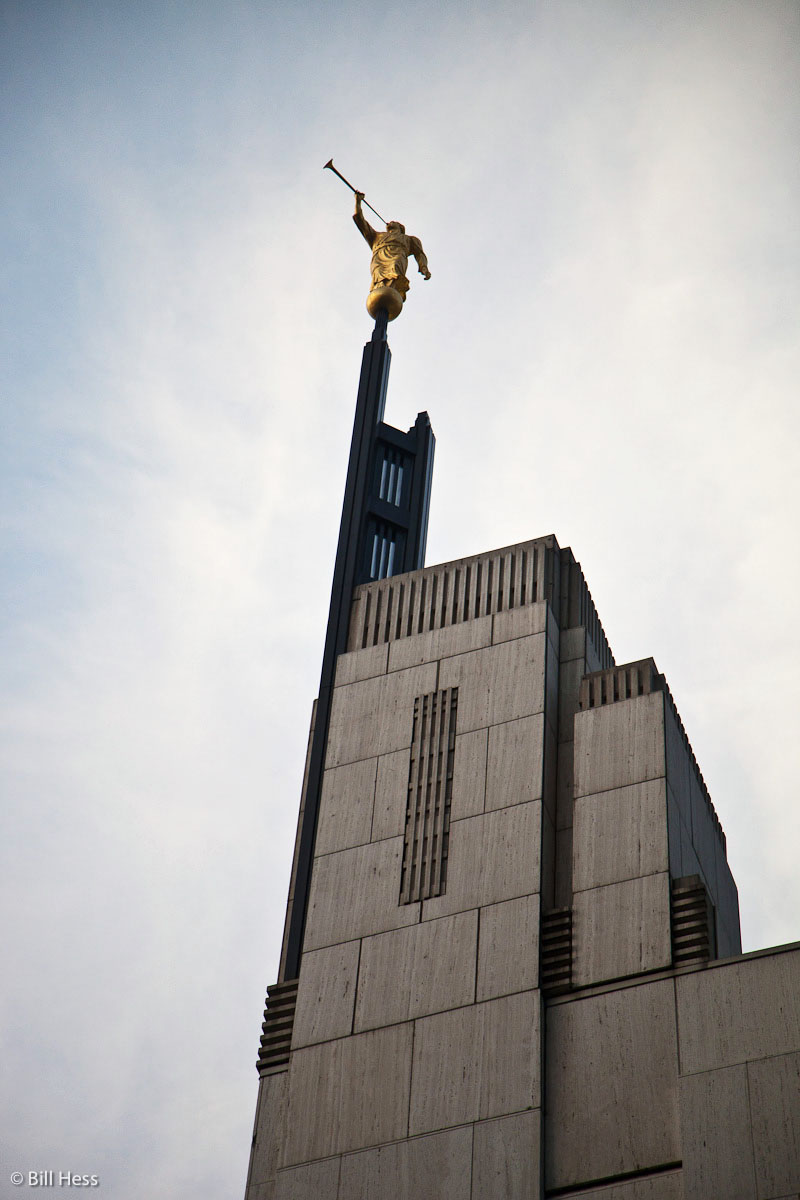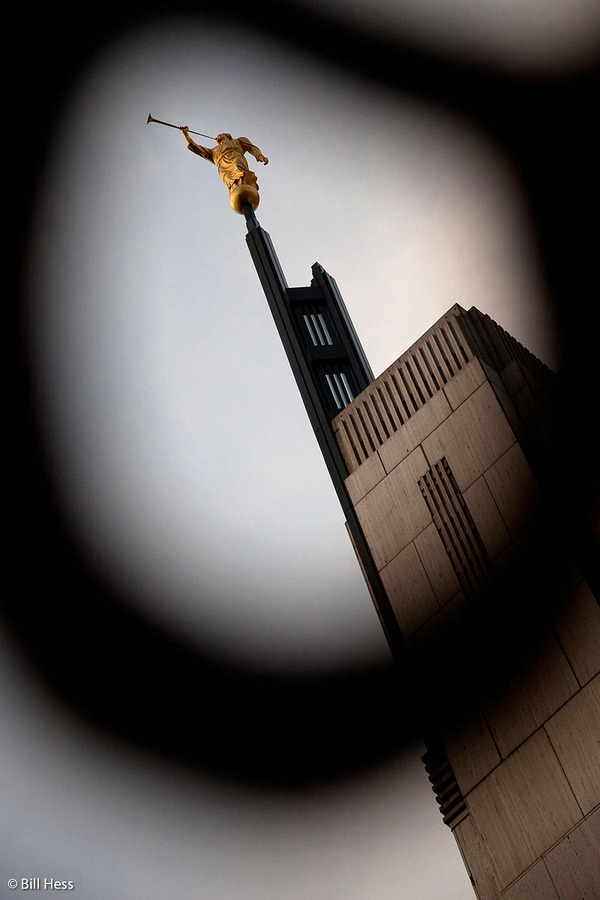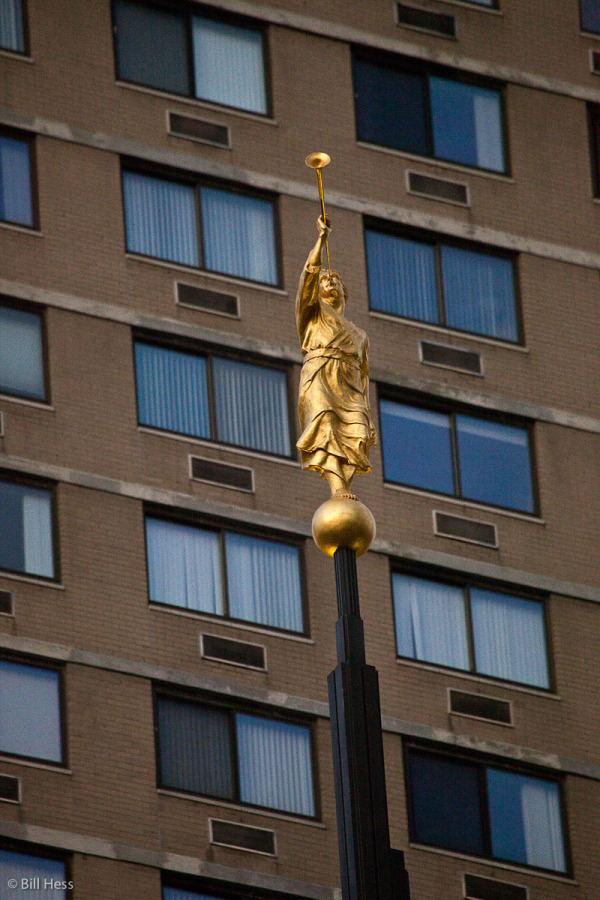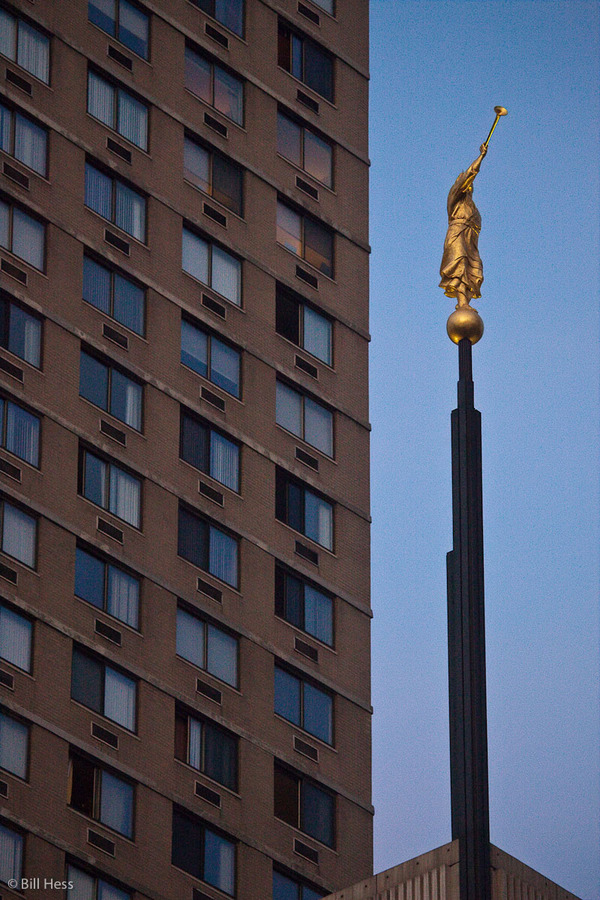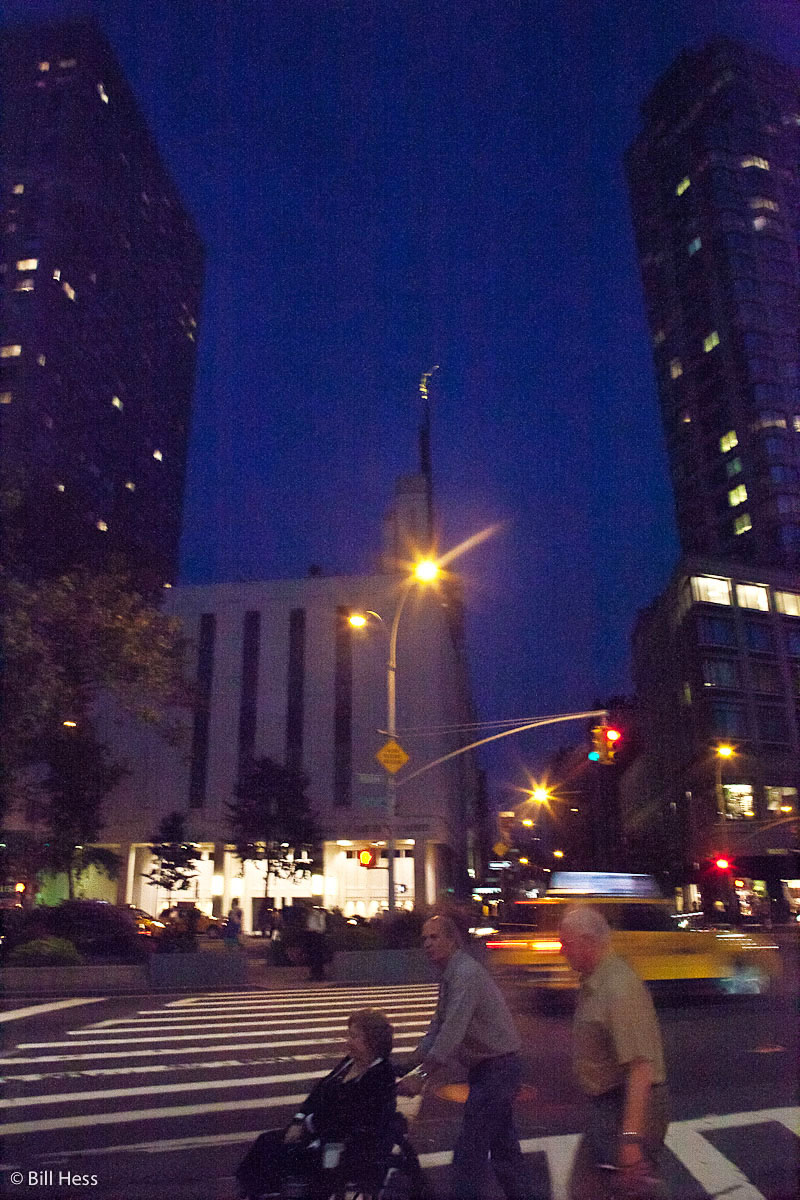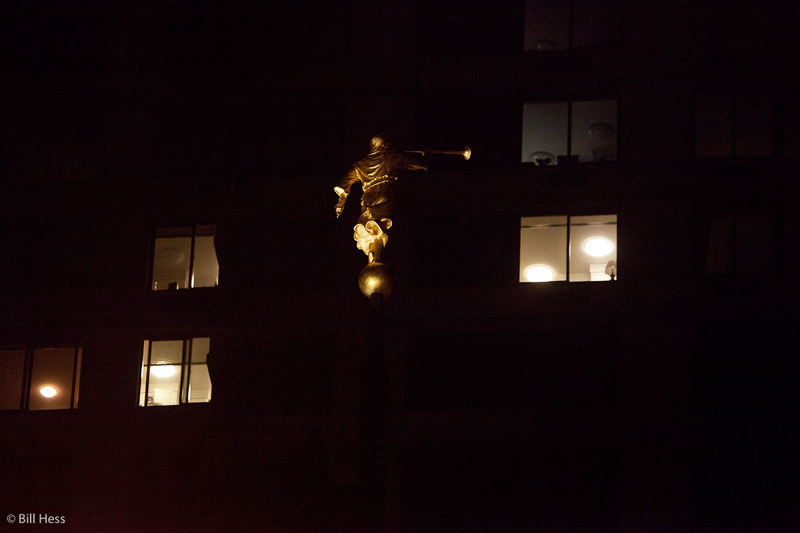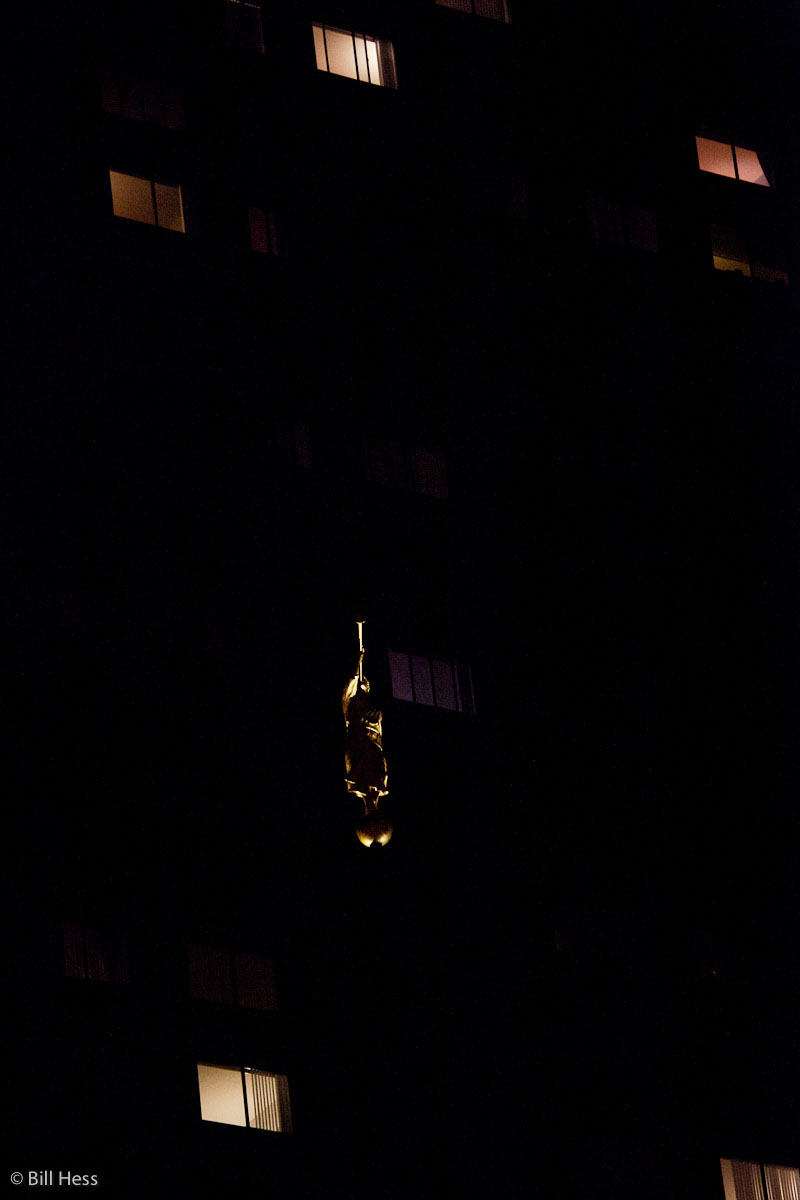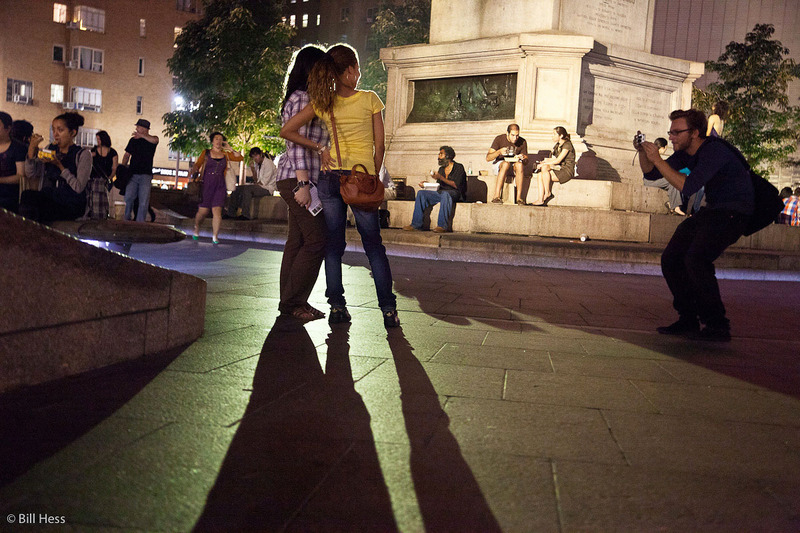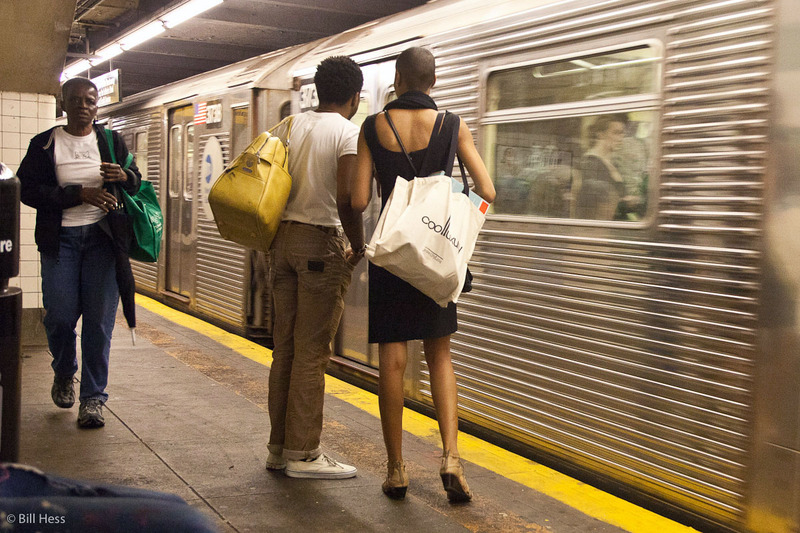David Alan Harvey Loft Workshop, entry 6: My personal history with race and the Mormon Church - or - how I fell in love with, met, courted, engaged, lost and married my wife
 Wednesday, January 11, 2012 at 9:57PM
Wednesday, January 11, 2012 at 9:57PM Looking Back at Me: I fell in love with my wife before I ever met her, or even saw a picture of her. It happened when three words slipped through the lips of Sister Martyna White Hawk, a Mormon youth missionary from South Dakota's Pine Ridge Indian Reservation... but I have gotten a bit ahead of myself. So let me back up just a bit...
...here I am, backed up a bit, down on the street below the gold-gilded statue of the Angel Moroni, perched atop the spire of the Manhattan New York Temple. He holds his trumpet to his lips, ready to herald the Second Coming of Christ, who will come from the east.
I am now in my second day of trying to shoot a photo essay on Mormon missionaries in New York City. I had not planned to shoot such an essay, but had spontaneously switched from another, hazy, plan at the suggestion of David Alan Harvey, who had just seen three of my missionary images in the short slide show that I had used to introduce myself to the other participants in David's Loft Workshop in Brooklyn.
My first day on the essay had been an utter failure. I had failed to contact a single Mormon, let alone a missionary. I managed only to photograph the Moroni statue from a few different angles in fading light.
On the morning of this, the second shooting day, I had finally got a call through to a Mormon who informed me that all the missionaries in New York City were about to begin a mission conference at a Mormon church housed in the same building as the temple, but not consecrated as part of the temple. I informed David of this at the beginning of the morning workshop session. He said I must go right now, pulled some cash out of his wallet, called for contribitions from others, and then shoved enough bills at me to cover cab fare from Brooklyn to Uptown Manhattan - about $30.
The cab driver expertly worked his way through what seemed to me to be impossibly congested traffic and dropped me off just outside the temple, a bit more than half-an-hour later. I entered through the door that serves both the temple, closed to those without temple recommends, the church house and various offices. Inside, I found a Polynesian doorman, clean-cut, dressed in a dark suit, white shirt and tie. He directed me to the chapel area on the third floor where the conference was taking place in a gymnasium. The doors were closed. I could not just barge in. I returned to the doorman, who then directed me to a public information office on the second floor. Inside, I found a pleasant, clean-cut, young man, also dressed in suit, white shirt and tie.
My hair was long and shaggy and so was my beard. I had planned to get both cut and trimmed before I left Alaska, but never got the chance. I felt most self-conscious, because I know from long experience that Mormons in authority can take matters of dress and grooming most seriously.
I explained my purpose to him and told him that I had served a mission decades before, and had for many years been conducting a sporadic project to photograph Mormon missionaries whenever I happened upon them.
He seemed willing to help, but lacked the authority to grant me mission cooperation. He led me back up to the third floor, opened the door to the back of the meeting room just a bit more than a crack and signaled another, older, public information officer, clean-cut, spiffily dressed in a suit, white shirt and tie, to join us in the hallway.
The young one introduced us, and then explained my purpose to the older, adding that I was a returned missionary and "an active member of the church."
The later description threw me a bit, because I have not been active in decades, had not said I was and did not want to advance a false claim. Yet, it did not seem wise to correct him, so I didn't.
The older fellow also struck me as friendly, willing to help, but he too lacked the authority. He stated that I would need to talk to the mission president, who would be tied up in meetings until lunch and perhaps beyond. He suggested that I come back in a couple of hours.
I agreed. I then asked the younger to direct me to the nearest barber shop. He did - about five blocks away.
There is an Apple store about two blocks from the temple where one can take any kind of malfunctioning Apple product for a free diagnosis. I had brought my laptop with me in the hope that I could have the screen fixed in time to edit this day's take. So, before I walked to the barber shop, I dropped into the Apple store. I put my name on a waiting list for an hour later. Staff assured me that I would be seen within ten minutes of the scheduled time, the diagnosis would happen swiftly, probably less than ten minutes, and the repair scheduled - likely before the afternoon ended.
I returned, clean cut, 15 minutes before the scheduled time. I sat down, opened up my laptop, and waited for my name to be called. My malfunctioning monitor did an excellent job of catching the reflections of staff and customers.
My appointed time came and went - 10 minutes, 15, 20, half-an-hour, 40 minutes... without my name being called. I grew nervous. Of course, I know that one needs to be at a meeting on time, but David had stressed to always, "go early." Even an hour early; two hours early. It doesn't matter if you have a long, boring, wait. What matters is that you ultimately get the pictures.
I did not want to be one minute late. So, about 20 minutes before the two-hour mark, I packed up my laptop, left the store and headed back toward the meeting.
Most Mormon churchhouses come with a chapel, a gymasium and a stage. Mormons tend to love basketball and the gyms prove perfect for other gatherings as well, from potlucks to memorial viewings, to gatherings to watch plays on the stage and to place rows of folding, steel, chairs when the congregation overflows the chapel, as it does for certain services. In my mission, Mormon chapels sometimes contained the only indoor gym in a reservation village - and certainly the only one other than the school, if the school had one at all.
A significant portion of our missionary work was devoted to basketball. The Northern Indian Mission encompassed North and South Dakota, Eastern Montana, Eastern Wyoming, Northern Nebraska and Western Minnesota. The NIM staged an annual basketball tournament with a series of local and regional playoffs - all leading up to the mission championship tournament in Rapid City.
Until I got distracted by surfing, I had been a promising high school wrestler and had played football until my senior year, when, to everybody's dismay, I left the sport behind to become yearbook photographer. Many adults shook their heads in disgust. They lamented that by shedding my football pads for a camera, I, one of the shortest and lightest players (yet pound for pound the toughest, the coach once said) on the football team, had just thrown away my entire future - FOR A CAMERA!!!
I had never cared to play basketball at all, but I took my missionary work seriously. When I became Senior Campanion in Fort Thompson on the Crow Creek Sioux Reservation, I set out to organize a basketball team. The events that followed played out almost like a classic, underdog, sports movie. I recruited my team almost exclusively from the most ornery, delinquent, teenaged-hell raisers and trouble makers on the reservation.
They all loved to play basketball, and they were good - no they were great. Maybe they got into trouble. Maybe they drank and swore, fought and fucked, and pissed in public places when they felt the need, but their hearts were big, their brains intelligent and they knew the game of basketball well. It was sometimes a challenge, but we got along great, these hellraisers and I.
To qualify for the tournaments, a player had to reach a certain record of church and seminary attendance, whether they were Mormons or not. None of my players were Mormon, but they all became regulars at Sunday school and seminary. The least skilled player among them knew much more about the game than did I, so my basic method of coaching was to bring them to the huddle, say, "go out there and do whatever the hell it is you do" and then turn them loose. Then they would go out and win, game after game.
They beat everybody they came up against, they won district, they won regional and then I took them to Rapid City, where they defeated all contenders until finally it was time to battle Pine Ridge for the championship.
Pine Ridge was a much larger community than Fort Thompson. Despite all the victories my boys had racked up, when the human skyscrapers from Pine Ridge dribbled onto the court, clad in menacing black-trimmed red uniforms, I feared the run might be over. It looked to me like that they had to average a good six-and-a-half feet or more in height. My players averaged less than six - a number were shorter than me, at five-foot, seven-and-a-half. The Pine Ridge bench was deep, Fort Thompson's shallow.
Worse yet, their coach was the Shoshone missionary who had become my senior campanion on my tenth day in the field - and so served as my break-in Elder. He was athletic, strong, intelligent and ambitious, yet had a certain sense of insecurity that made him always want to prove himself superior in all things, whether it be "scripture blast" or the ball court. Every day that it was possible, he made me go one on one against him in basketball and then lorded his victory over me.
He wrestled me once. That did not go well for him, so he never wrestled me again.
Now, he looked proud and confident as he stood on the sidelines with his youthful skyscrapers. He greeted me with that same "I'm going to kick your butt" grin that he had always flashed at me before every one-on-one game that we had ever played.
"How did you ever get here, anyway?" he asked when we shook hands. "It doesn't matter. You're doomed."
But... YES!... YES!... YES! My boys beat his boys! It was a classic, come from behind squeaker finish - I can't remember the score, but we won. I was awarded my own little trophy as coach of the Northern Indian Mission Championship basketball team.
Now, I found the mission president in the gym taking individual snapshots of the New York City Mormon missionares. The scene had irresistible appeal to me and I had a strong feeling that if I did not get a shot off now, I might never get another chance to photograph any of the missionaries gathered here, period.
I briedfly told him what I wanted to do, said, "this would be a good place to start," and then shot this picture. He raised his right hand slightly, then stepped back from his picture taking to talk to me.
He was friendly but reserved, and listened intently as I explained in more detail the project that I hoped to shoot.
He answered, "it will be impossible for you" to do a photo essay on Mormon missionaries at work in New York City. Then, he backed off that statement just a bit and said there was only one way that I might get some pictures of missionaries working in the city... if I just happened by chance to come across a pair somewhere out in New York as they went about their work and then took some pictures of them. That was the only way. Nothing else was possible.
We were together in a room in which every missionary working in the city had gathered, and he had just told me it was going to be impossible for me to photograph them, except by chance encounter. For the reasons stated in my entry of January 6, I had expected this result and so was not surprised. Yet, I was not ready to give up.
I noted that all these missionaries were right here, right now, and could we maybe at least talk a little more and see if we could find a way for me to photograph some of them? He said to come back in 15 minutes, we could talk, and he would give me the parameters I would need to follow if I by chance I were to photograph any of "my missionaries."
I wandered over to a seat near the near the far back corner of the gym, sat down and began to wait.
A few minutes later, the older of the two PR officers, who stood much taller than me, walked up close to where I sat and looked down into my face with a stern look upon his. He told me that this was a gathering for the missionaries and their church guests only and that I should leave now. I mentioned that the mission president had told me to wait 15 minutes and had promised to talk to me then.
Keeping both his expression and countenance stern, he emphatically stated that the president was busy and had no time for me. As gently as I knew how, I again brought up the mission president's promise to talk to me, 15 minutes following our earlier, brief, conversation.
He then stated that the president would be busy for another five hours.
"Come back in five hours," he said.
I returned to the Apple Store, signed up again for the first available time, then waited for about an hour beyond that until my name was called. The technician who saw me quickly diagnosed the problem. The cable from the computer to the monitor had gone bad. Both it and the monitor would have to replaced, at a cost of $350. He told me to bring my laptop back in at 9:00 in the morning for repair the next day.
I was distressed. I did not want to have to carry the laptop with me for the rest of the day, nor did I want to take the time to bring it back in the morning or to come back and get it later in the day. Yet, I needed it. How could I edit and prepare my slideshow without it? This would also mean I would have to miss the first part of the Loft workshop and critique the following day - and I had missed it all today.
With plenty of time yet to kill, I wandered slowly about, did a number of people shots, plus a few more of Moroni and the temple. I wondered where this young woman, standing with her rolling suitcase, was going? Where had she come from?
Given the cut of her dress, I felt confident that she was neither going into or leaving the temple, but I found her bag an appropriate metaphor of the temple's purpose in Mormon belief. In so many ways, Mormons see the temple as a way station between mortality and eternity. It is a place where sacred promises and covenants are made to help ensure that those who make them will gain eternal life in the Celestial Kingdom, in the presence of both God and Jesus. All who experience these rites are sworn never to talk about their content outside temple walls - not even among themselves: not because the rites are shocking - they are not - but simply because they are considered sacred.
When I was small and Mom would sit at my bedside and pass along the history and teachings of the church, the stories of the Bible, The Book of Mormon, The Doctrine and Covenants, of God, Jesus, the ancient and modern prophets, including Joseph Smith and David O'Mckay, she would also often speak of the temple and how important it was that I live a clean, righteous, chaste, life so that when the time came, I would be worthy to enter the temple - and the Celestial Kingdom thereafter - along with my wife, children, parents and all members of my righteous and eternal family.
Nothing that I would ever do would be more important than to be ordained into the Priesthood and to marry the right woman in the temple. Mormons do not believe in "until death do you part" but rather in marriage for "time and all eternity."
When the time came for me to marry, these were the traits I must seek out in a potential mate: she must be Mormon, chaste and worthy to enter and wed in the temple. She must also be white. Almost certainly, she would be a woman who I had known as a spirit in the preexistance, when we would have already chosen each other as mates.
From the earliest days of the church, Mormons had been converted from across the race spectrum, including those with African blood. At first, if they lived worthy lives, all Mormons could enter the temple and partake in its sacred rites. After the death of Joseph Smith, Brigham Young decreed that those with African blood - even one drop - could not enter the temple. Males of African descent could not hold the Priesthood.
As it was taught to me by my mother, I did not know about the early black Mormons. I thought it had always been this way, back to the day when Cain had slain Abel. According to her understanding, Mom explained that in the prelife, there had been a great war in heaven. One-third of God's spirit children had chosen to follow Lucifer, who wanted to force every person to be righteous and thus insure their eternal salvation. The remainder chose the plan Jesus had advanced, in which he would be the one to bring the gospel of freeagency to the earth. At the conclusion of this great war in Heaven, the followers of Jesus cast the followers of Lucifer into outer darkness, where they could never take on bodies or participate in the resurrection.
There was a third group, Mom taught me. They did not follow Lucifer, but they did not really join in the battle to expel him and his followers. They had been lazy, willing to sit back and let others do the hard work. Still, they had the right to be born, to be resurrected. Were they to live righteously on Earth, follow and keep the commandments, they could still ultimately earn their celestial glory, but, due to their sloth in the pre-existence, the burden here was greater for them. Their males could not hold the Priesthood. They could not enter or marry in the temple. To ensure that we would recognize them and not mingle our blood with theirs', they carried the Mark of Cain - black skin.
So taught my devout and loving mother, as she sat at my bedside. As I grew and attended Sunday School, church and ultimately Priesthood Meetings, all of her words seemed there to be confirmed.
In matters of race, the Mormon Church has advanced far since the dark racial days that it dwelled in during the time of my childhood and youth. I now read that these things that my mother taught me and that seemed to be confirmed at church were misunderstandings advanced by many members but never backed up by recognized scripture.
When you are a small child, you believe what your mother teaches - especially if she is as sincere, loving, and earnest as was mine. I grew up in all-white neighborhoods, with no one to challenge these assertions. Yet, by 1978, my associations had enlarged and my perception of the world and of race had changed. I was still an active Mormon, but my mind was plagued by many questions about many things Mormon - teachings and attitudes on race being in the top tier. One day in that year, I was driving with Margie into East Fork Canyon on her White Mountain Apache reservation. The car radio was tuned to the news. To my great surprise and relief, it was announced that Spencer W. Kimball, President and Prophet of the Mormon Church, had announced a revelation that put an end to this discrimination.
From that day onward, "the fullness of the everlasting gospel, including celestial marriage, and the priesthood, and the blessings of the temple," would be open "to all men, without reference to race or color, solely on the basis of personal worthiness."
Blacks Mormon males could now hold the priesthood and serve missions. All worthy black Mormons could now enter the temple and participate in all its rights, including marriage. I was so relieved to hear that story, thrilled. Yet, it also left me troubled. Why had I ever been taught this doctrine of racial discrimination? Why had I been raised to grow up believing it to be the Word of God? Why had I ever taught this doctrine of discrimination to others - including to black people?
With pain, I often remembered a set of young brothers who my companion and I had taught in the missionfield. They believed our words and wanted to be baptized. They wanted to enroll in the LDS Indian Placement program, in which they would spend their school months living with a Mormon family in Idaho and attending school there and their summers back home on the reservation. How crushed they were when the time to enroll came and they were denied, because their lineage included African blood. And it was I who had been the biggest influence in leading them to that disappointment. Then there was a young woman, a couple of years older than me, whose black and Lakota blood had combined to create one the most beautiful women I had ever seen.
When I met her, she was already a converted Mormon, devote, sincere and dedicated. She never missed church. Yet, she had turned away from romance with potential Mormon suitors, because she did not want to burden a Priesthood holder by enticing him into marriage with a woman she did not believe he would ever be able to take to the temple. She married a Protestant minister instead, but in time, converted him to Mormonism and so put him in the very spot she had tried to keep other suitors out of. We spent some long and painful hours discussing the situation.
Last I heard, their marriage had been sealed in the temple for time and all eternity. I know nothing of their status today.
My heritage, my family, was Mormon. My great, great, great... grandfather had sat in jail with Joseph Smith had set out across the plains with Brigham Young, who had conducted a number of marriage ceremonies for him as he gathered together his seven wives and fathered his 63 children.
My closest friends were mostly Mormon. I did not want to alienate myself from them or to hurt any of them - especially my mother. I did not want my loss of faith to be an instrument in weakening their faith. I did not want them to lose their faith. I could see that they got much good out of it and did not know what would become of them if they lost it.
I carried on as best I could, stalwart Mormon on the outside, torn on the inside by this and many other issues for three more years. Then I moved my family to Alaska. No one in Alaska knew my history. Few here recognized me as Mormon. Still, for the sake of my heritage, my mother, I made some weak attempts to attend church. In the Wasilla ward I attended, the bishop and his counselors were all hard right wing politcally. They mixed up their politics and religious beliefs and in front of their congregation presented them as one; they spoke of their politics as God's politics. I recognized this as nonsense, not church teaching, knew from experience that we of more liberal bent had our place in the church, too, but I was put in the awkward spot of either having to appear to agree with them or of becoming a disruptive force at church meetings - which, in fact, I did become. I was not comfortable. I did not fit in. I quit attending. So did Margie, and all our children.
We raised our children in a question mark, teaching them no religious doctrine at all. Although I have witnessed those painful times when my children have been lost and wandering, I do not feel bad about this. This life and eternity is all a question mark to me; a great mystery. My children can discover their truths for themselves. I will not tell them what they must believe. To feel lost and to wander is part of the process - a process that I remain engaged in.
There is no wanderer more lost than I - it is the search that sustains me, that keeps the needle out of my arm, the alcohol from overpowering my cells, the self-fired bullet from piercing my brain. Yes, these tendencies are all strong within me. It is the search that holds them at bay.
Oh, boy - I did not mean to go off on this tangent. I just wanted to briefly relate how the second day went for me and to tell the story of how it was that Margie and I came to marry. So I had better hustle along and get to it, before those few of you who are still here leave.
Anyway, my hope for official cooperation in shooting my essay had been dashed. Still, I had set out to take Mormon missionary pictures. I was not going to let the day end without doing so. I could dutifully wait until the five hour period came to an end and then try to see the president. If I succeeded, and he actually talked to me, I reasoned that by the time our meeting ended all the missionaries gathered here would be gone and dispersed.
I had one hope - to do just what the mission president himself had suggested: to happen upon some missionaries at work in New York City. There would be no better chance to happen upon some than when they left the conference and ventured back to their posts in the city.
Well before the five hour period neared its end, I sat down upon a park bench across the street and waited. I imagined that after the meeting, the missionaries would all come outside, gather together for a group photo, and then spend a bit of time visiting and taking individual photos before they left - just as we had done in NIM.
I planned to discreetly take a few photos of this process, pick a pair of missionaries, wait until they left and then introduce myself, follow them and document whatever tiny sliver of their lives might reveal itself to me.
Instead, after what seemed an interminable wait, two missionaries came out by all by themselves and quickly descended into the subway. About 20 minutes or so later, two more exited and did the same.
A bit later, another pair came out, carrying boxes.
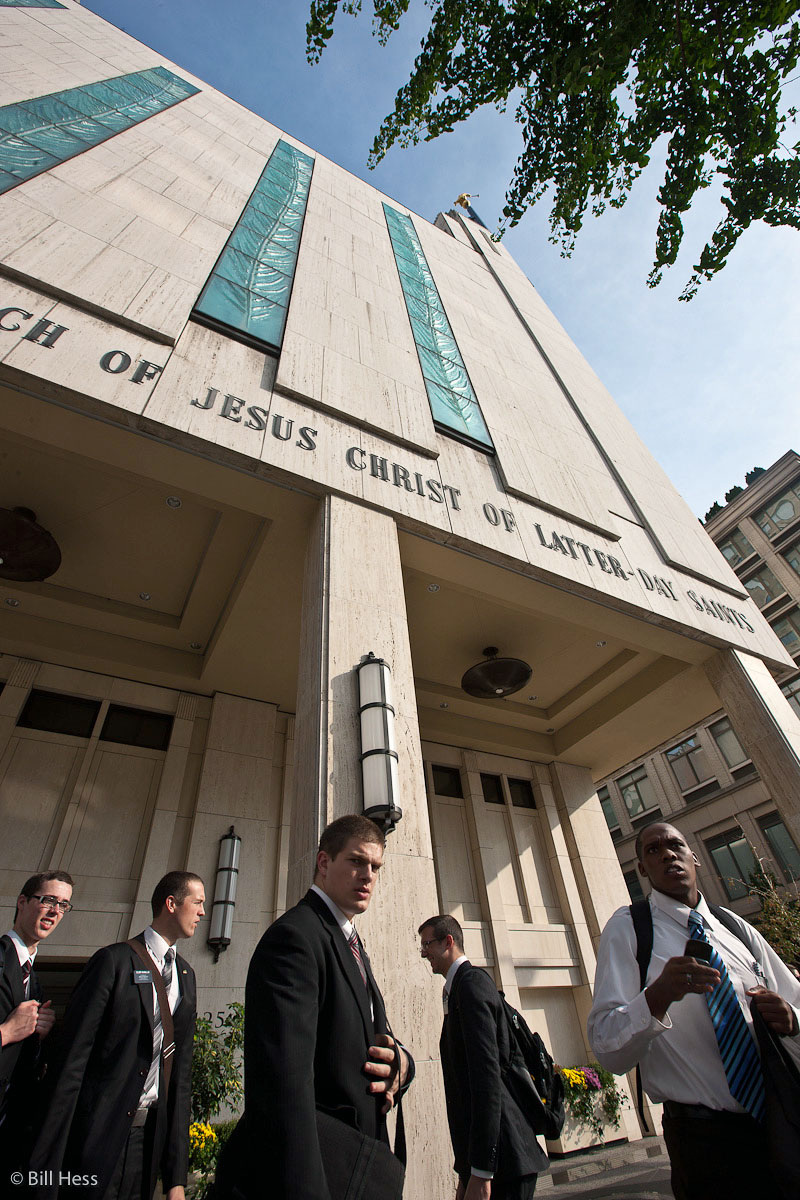
I reasoned that the president must be holding individual interviews with each missionary; there would be no group gathering. The president would not come out until he had spoken with the last of his missionaries. That could be hours yet and by then every missionary would be gone.
In the meantime, I needed to pick a pair, introduce myself and follow along. Then came a long gap of maybe 40 minutes when no more Elders left the building. Finally, a group of six young Elders exited at once - these five and Elder Bussard. It was time to go for it. For the reasons stated above, there were no black Mormon missionaries when I served, so I decided to try my luck with the black missionary and his companion.
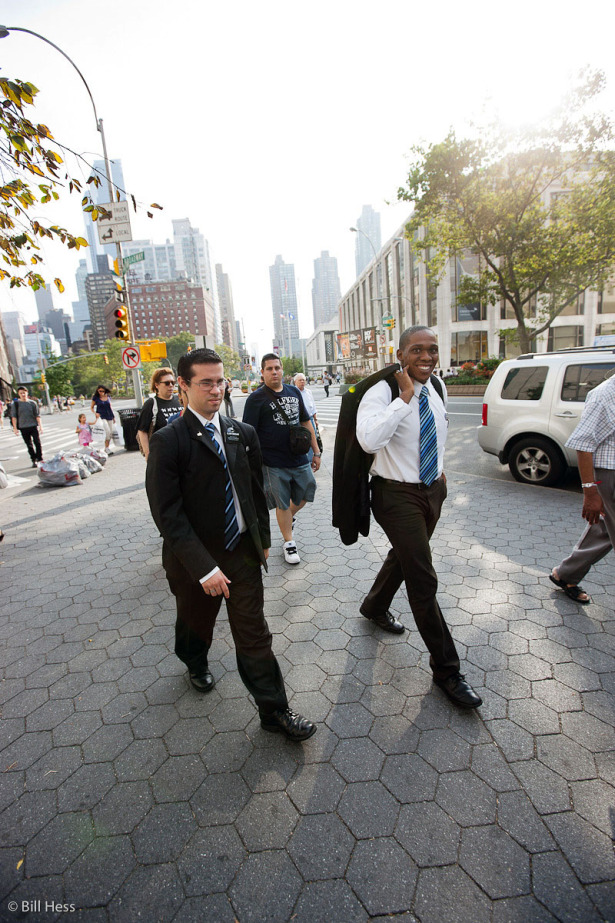
They broke from the group and walked toward the subway entrance, probably less than 200 feet away. I scurried up to them, introduced myself, told them what I was doing and asked if they would mind if I followed. As every set of missionaries that I have ever approached has been, Elders Bussard and Matthews were friendly and agreeable. Whether they were comfortable with the idea might be another story, but they were friendly and agreeable.
I followed them into the subway. A train soon pulled up. A crowd surged out and another surged in. Elder Matthews, the black elder and obviously the senior companion, looked at the crowd in dismay. "That's one thing I don't like about New York," he told me, "The subway gets too crowded. We'll wait for the next train and see if it is any better."
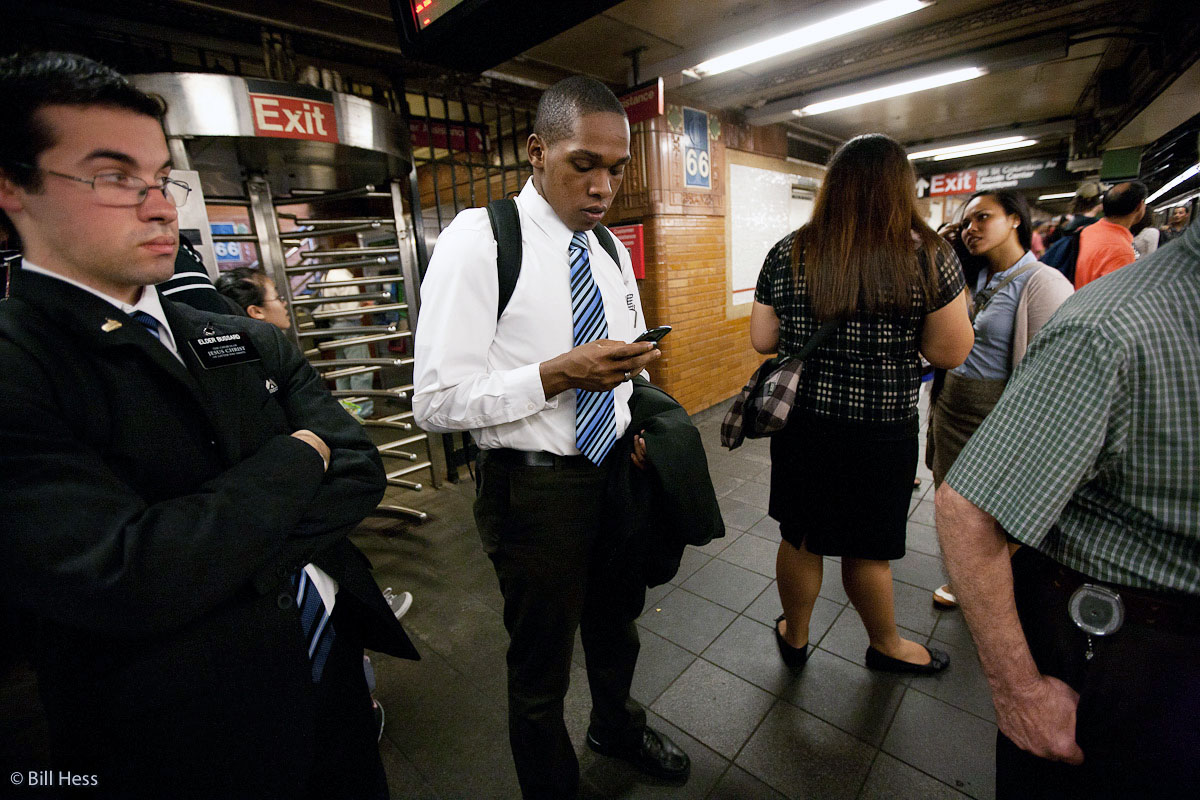
As we waited, two more more Mormon missionaries came down the stairs and onto the platform - "lady missionaries," sisters - both of them Polynesian, the two women at right. Now, I return to the Looking Back at Me story that I began with - the story about how I fell in love with, then met, courted, won, lost and then married Margie.
Margie's grandfather is said to have been the first White Mountain Apache ever to baptised into the Mormon Church. While she grew up in an often tumultuous manner, she did grow up Mormon and upon graduation from a Utah high school and the Mormon Indian Placement Program, attended Brigham Young University. After two years, she volunteered to serve a full-time mission and was sent to the NIM - about the same time as I was.
In time, she wound up stationed in Manderson, South Dakota, on the Pine Ridge Reservation. Manderson is just a few miles from Wounded Knee where, on December 29, 1890, the Seventh Calvary massacred at least 150 beaten-down Lakota and possibly as many as 300 - most of them women, children or elderly.
There, Margie befriended a teenaged Mormon Lakota girl by the name of Martyna White Hawk, who quickly came to admire and love her, and was strongly influenced by her. Martyna then volunteered to serve a "youth mission" and was sent to Fort Thompson, where I was stationed. She was teamed up with a full-time lady missionary - a boisterous, daring, cowgirl from the high Rockies in Colorado, who struck me as half-crazy and who always wanted to prove herself to be the toughest man in any room that she entered or field that she walked upon.
I was their District Leader, and had near daily interaction with both of them. One day, during a serious discussion focused on the trials of this life, Sister White Hawk began to tell me about a lady missionary stationed in Manderson, an Apache from Arizona, who had helped her through some hard times. Then she spoke the three most beautiful words that I had ever heard: "Sister Margie Roosevelt..."
I fell instantly in love.
Yet, I knew this to be absurd, hopeless, ridiculous. I had never even seen a picture of this Sister Margie Roosevelt. I had no idea what she looked like nor the nature of her personality. Besides, it could never be. Right there in the very missionary and seminary lessons that she and I were teaching to Lakota and Dakota were words of counsel, urging those we taught to marry someone of their own race, in the temple.
I did not like to teach those words. Many of those we taught were already members of the church, sincere believers, and a few of them were interracially married. When they heard or read those words, they would ask if they had done something wrong by marrying each other. In these words it seemed to me that we, who were forever preaching about the values of a good marriage, were attacking the marriages of mixed couples living in hard circumstance who looked to us for guidance.
In the Book of Mormon, I had read the words, "white and delightsome" to describe the righteous Nephites, and "dark and loathsome" to describe the wicked Lamanites - both said to be descended from the Israelite Lehi, who led his family from Israel to the Americas. It was Mormon belief that among those Native Americans they called Lamanites were many who would be converted to the gospel, who would become among the most rigtheous and valiant children of Israel and would one day help guide the church through "the last days" to the time of the Second Coming of Christ. They would become "white and delightsome," as their ancestor Lehi had been.
When my mother had sat at my bedside to teach me these things, it had sounded right. But when I got out among the Lakota and Dakota people, I no longer liked the sound of it. I did not like to teach it as doctrine. I had never seen any people more beautiful than those I had been sent to put on the road toward becoming "white and delightsome." I did not want to see them lose the beautiful dark skin and gorgeous black hair that brought out this beauty of who they naturally were.
It also troubled me to give lessons that stated that I must marry a white woman. Yet, that's what my mother had taught me. That's what had been ingrained into me through so many years of church lessons.
Now, I was in love with a dark-skinned Apache woman who I had never seen and I wanted to marry her.
The desire was absurd. It couldn't be.
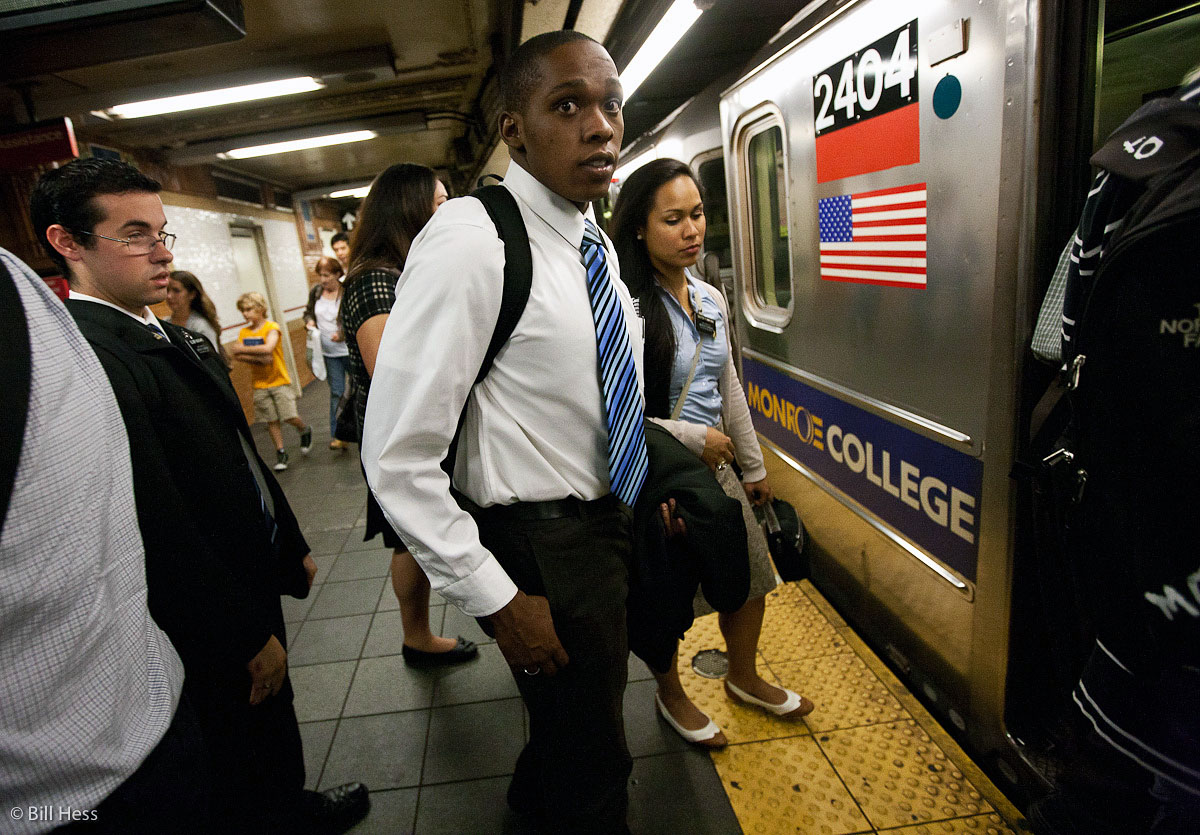
Probably, I would never get to know this Sister Margie Roosevelt anyway, so what did it matter?
A month or so after I first heard Martyna speak Margie's name, I went to a mission conference in Rosebud and she was there, sitting in the distance with her companion. Afterwards, all the missionaries gathered outside the chapel for pictures, and to visit and mingle with each other. Finally, I met the woman I already loved, face to face.
Her hair was long, jet, black, thick, a bit wavy, her skin dark and delightsome; beautiful. Her smile was gentle, lovely and there was fun in the spark of her eyes. There was something natural and unstrained between us. When we talked, it was as though I spoke not to a stranger, but to someone I had always known - perhaps as a spirit in the preexistence.
Now, back to the Lincoln Center subway station in New York: as you can see above, another train came, the four missionaries boarded and I followed, camera in hand...
...maybe it wasn't as crowded as the train Elder Matthews had let pass, but it was still crowded...
After Rosebud, Sister Roosevelt vanished from my sight, but not my mind. There, and in my longing heart, her place had become permanent. At the end of summer, I drove from Fort Thompson to the mission home to take care of some mission matters.
Sister Roosevelt just happened to be at the mission home. Mormon missionaries are never supposed to be alone with members of the opposite sex - in fact, missionaries are never supposed to be alone without their companion, period. A missionary is required to be with his or her companion, or another missionary, twenty-four hours a day, seven days a week, to help each other avoid temptation.
Somehow, Margie and I found ourselves all alone, in the driveway to the mission home. She leaned languidly but innocently back against the mission president's two-tone LTD and we talked, alone, for a good 15 minutes. Then we parted.
I spent that night with a pair of Elders stationed in downtown Rapid City. It was a hot and busy night and as I lay in bed, I could hear the sounds of young people cruising, car engines revving, motorcycles being shifted through their gears, the roar of their engines rising and falling.
After the quiet that usually surrounded our country quarters on the reservation, the noise of downtown Rapid City was striking - and inviting. I wanted to be out there, on those hot, loud and noisy streets - driving a motorcycle with Margie sitting behind me, her arms wrapped tightly around my chest - or maybe in a car, just driving, she leaning into me, her left arm intertwined with my right, her head against my shoulder, her long hair falling across my shirt, her face lifting to mine at red lights or reckless moments to allow her warm, moist, lips to lock with mine; she there at my side to ride with me through this life and forever.
I did not see her again or hear anything about her current activities until early fall. I had just finished my mission, and had enrolled back into BYU. It was Sunday, the sun bright and warm but not hot; a tiny tinge of orange and yellow in the green leaves heralded oncoming autumn.
I was walking across what seemed to be a nearly empty campus between the Harris Fine Arts Center and the Wilkinson Student Center when I spotted a beauty with long, black hair and a modest yet form-fitting knee length yellow dress, walking towards me. It was her. We stopped. We talked. I walked away smitten and helpless, filled with hopeless desire.
By then, I was dating another girl, a white girl, blond, a freshman, smart, very pretty, trying to make it work, trying to pretend that she was the woman that I was meant to court all the way to the temple. Yet, it did not feel quite right. As pretty as she was, in my mind I could always see that long, black hair, that beautiful dark skin and face... yet, I had been taught all my life that a union with the one from whose head that hair fell would be contrary to the will of God.
After that chance Sunday meeting, nearly two semesters would pass by before I saw Margie again. In the meantime, the relationship with the blond had quickly failed. After that, all the girls that I dated were American Indian, all tied one way or another into the Northern Indian Mission. There were two Dakota girls from Fort Thompson, a member and a non-Mormon who I had worked closely with and who decided to come to BYU as a result. We never dated with romance on mind. We were just friends, who enjoyed each other's company.
The girl I dated the most was Navajo. In the final summer of my mission, she had come to Poplar, Montana, on the Fort Peck reservation, not as a missionary but to teach children behind their grade levels how to read in a church-funded educational program. She was short, petite, beautiful and vivacious, completely full of fun. We liked each other greatly and in a way, truly did love each other as well, but we, too, dated not in search of romance, but for friendship and companionship, because we got along extremely well and enjoyed each other's company.
A number of times, as we talked about our hoped for futures, she would say that she could never marry a white man, no matter how much she might care for him. It would not be natural; it would not be right.
I did not see Margie again until the end of spring semester, when we crossed paths in the Wilkinson Center cafeteria. We sat down, ate lunch together and shared our summer plans. She was going to do some summer school but also planned to return home to the White Mountain Apache reservation for awhile to work. I was headed to Southeast Alaska to participate in a summer journalism program.
I returned to BYU for fall semester. Just before classes started, I was again in the Wilkinson Center, Cafeteria, this time with my mentor, Nelson Wadsworth, the Time-Life veteran who taught me what photojournalism was supposed to be, and a top photojournalism student, Roger Hatch, who would graduate and then go on to manage a water plant. We had come together to discuss what we were going to do with the student newspaper, but, as I passed through the check-out line just behind them, I spotted Margie sitting alone at a booth.
Without a word, I slipped away and sat down at the table with her.
"How was Alaska?" she asked.
That was it, my friends. We have been together ever since.
Of course, it was not so simple and ever blissful as this might make it sound. I had barely begun to date Margie when it suddenly seemed that just about every other returned missionary from NIM got the same idea. There were Polynesian RM's, white RM's, Navajo RM's, Shoshone... all coming, calling on the phone or knocking on the door as we lounged about on the rug in her apartment living room, or coming up to us when we stood somewhere talking, to insert himself between her and me to try and flirt with her.
I had planned to take my time in proposing to her, but I had to put a stop to this. Less than three weeks after our first date, I asked her to marry me. Five agonizing days later, she said yes. Together, we went out and bought a ring for her. It was Halloween, and there were goblins, witches and ghosts at the jewelry store window, peering in at us.
I should note that our second date had taken us to Salt Lake City. On the way back to Provo, we stopped at my parents' new home in Sandy. Dad was not there when we entered, but Mom was. She loved Margie instantly. Somehow, despite all that she had taught me about marriage, she knew that this dark-skinned, black-haired Apache was the woman I was going to marry and it would be good. In one instant, Mom dropped this life-long, heavily-ingrained prejudice forever.
Yet, we were not done with the affliction hammered in by that prejudice. After we had been engaged for a while, Margie was suddenly struck by doubt. She did not doubt that she loved me. This she knew. She doubted that God would want her to marry me, because she was brown and I was white and she had been firmly taught that this was not right.
We would discuss this for agonized hours at a time, and then she would come back around - for a day, two days, three... and then the doubts would come again. It became unbearable. Then the teachings I had been raised with rose again as well. I began to wonder, too. Maybe somewhere on BYU campus was the white girl that I had bonded with in the preexistence, the woman the Lord wanted me to marry, instead of dark brown Margie. When I would catch the glance of a white girl looking at me, I would wonder if maybe that was her. Margie and I broke up. She gave the ring back to me. I threw it across the room. Then, broken-hearted, we spent all of our time together, even more so than before. We skipped classes. Day and night we were together. The only place either of us could find any solace was in the grieving arms of the other.
Finally, we decided to totally separate for three full days and to fast and pray throughout. This would be a complete fast - no food, no water, no sustenance or liquid of any kind. Then, perhaps, the Lord would make His will known to us, whether He wanted us to marry or to break apart to join with partners of our separate races.
At the end of that three full days,* we planned meet at a certain place on campus and then walk from there to our favorite Mexican restaurant, pray together and break the fast.
Come the end of the three days, I felt famished, dehydrated and weak. My shoes felt as though they were made of lead and weighed 20 pounds each. To climb a flight of stairs was to struggle up a hard mountain.
I reached the designated place before she did and sat down upon a bench. The sun had set. It had grown dark. Lamps stood at uniform distances apart on the walkway that I knew would be her path toward me. I waited and watched. Soon, I saw her form appear in the conical light of the most distant lamp, tiny and small, but familiar - her black-trimmed red coat snugged tight in the waist and hanging just below her hips in a way that accentuated the shape of her body.
She soon stepped out of the light and disappeared into the darkness, only to soon reappear in the glow of the next lamp. And so she progressed, moving repeatedly from dark to light, each time coming a little closer, appearing a little larger than before, until finally she stood, full size and close, before me, looking lovingly at me, her face weak but serious, a touch of moisture in her eyes.
And what had come to me after three days of fasting and prayer? An answer from God? No. Physical weakness, that's what had come. I knew no more about the mind of God and His intent for me than I had before.
What I did know was that I loved this woman and it was not God's decision to make; it was mine, and hers, and no one else's, be they mortal or divine. God wouldn't mind. Whatever we decided would be okay with Him. He was not so small minded as so many Mormons and countless other religious people made Him out to be.
On February 14, we married, in the Provo Temple. It was good and we were greeted and treated warmly by all within, but I felt bad also. Margie's parents had driven all the way up from Arizona. They were Mormon, but not qualified by their lifestyle to enter the temple for the ceremony. They were denied the privilege of seeing their oldest child marry. Her father would die in a car crash eight months later, without ever witnessing the marriage of a single one of his 11 children. Ten months after our marriage, baby Jacob came to us.
Speaking of babies, I took the above picture of the two young Mormon Elders, Matthew and Bussard, and the bump of new human life, after the two sisters had got off at their stop and left the train.
*Should any of you ever go on a complete, foodless, waterless, three-day fast, DO NOT go out to eat at your favorite restaurant afterward. Break it with a bit of broth, a tiny bit of bread. Add to this gradually, over hours. We broke our fast with a feast. We suffered. I think we damn near died.
And here they are, Elders Bussard and Matthews, after getting off at their own stop. Given the history of the Mormon church in regards to members with African blood, I asked Matthews if it was ever hard, being a black Mormon missionary. Sometimes, in Harlem, he said. When he had served there, there were blacks who tried to give him a hard time about it. But it was okay, he smiled, because he would meet them on the basketball court and there teach them a few things - not only about basketball but about the Church of Jesus Christ of Latter Day Saints.
This, he bore his testimony to me, is God's true and living church and as a missionary he carried the word of God, the message of Jesus to all those, black, white, or otherwise, who would listen, and that was what mattered to him. He was loving it, he said. It was the greatest experience of his life so far.
Elder Bussard said he was loving it, too, and that it was his greatest experience as well.
I exited the subway and walked with them for a while. As is almost always the case when I meet young Mormon missionaries, I liked them, and felt empathy toward them. I would even say I loved them, as an older Marine might love a younger Marine. I had walked where they walk, had felt their fears, their hopes, their joys, their loneliness, longings and frustrations, had experienced their failures and their successes. I briefly entertained the thought that somehow, I might pick up with them again the next day and shoot my essay, but in a gentle way, Elder Matthews made it clear that this was not to be. He noted that there are missionaries in Brooklyn, where I was staying and where David Alan Harvey's loft is, and suggested that I look around and see if I could find some Elders there.
He was vague on what he and Elder Bussard would be doing the next day. For now, they were just going to return to their apartment to study and prepare. As we drew nearer to whatever building held that apartment, Elder Matthews seemed to grow nervous. It became clear to me that he could not take me to that place - most likely it was against mission rules to bring unauthorized visitors to their living quarters.
Mormon missionaries live with lots of rules.
So this was it - the conclusion of my failed attempt to shoot a photo essay on Mormon Missionaries at work in New York City. We stopped. Elder Matthews gave me his card and asked me to send him any "cool pictures" that I might have taken. "No hurry," he said. "Three, four months from now - whenever you get time."
Elder Bussard, the junior companion, had been mostly quiet throughout our little journey together. Now that look of concern one gets when he feels he is being left out came over his face. "I want you to send them to me, too," he said.
"When he sends them to me, I'll send them to you," Elder Matthews told him.
"Okay," he said.
I was not sure I would have any cool pictures. All we had done was to take a 115 block ride on a crowded train, followed by a very short, uneventful, walk together.
We said goodbye and shook hands - firmly, the way Mormons do. Then they stepped into the crosswalk, into the gaps between the onslaught of traffic that did not stop or slow for them. I shot a final frame, then turned around to walk back to the 181st Street Subway station.
Before I boarded the train, I dropped a dollar bill into his guitar case and took this picture. The idea did not occur to me then, but only just now, as I write these words alongside this photograph. What if I had just hung out with this guy? Made friends with him, shot my essay on him?
I can't say for sure it would have worked, but maybe it would have. It was now clear to me that it was going to be virtually impossible for me to shoot a full essay on Mormon missionaries in New York City. I had to come up with a new plan. It could have been him, but I just didn't think about it. There were only two full shooting days left in the week now, and I had lost two by taking this brief journey into my own past.
This is what the monitor on my laptop looked like. It was actually worse than what you see here, because the image constantly jumped about. Sprays of irridescent color repeatedly flashed across the screen. I had hoped it would be fixed by the time I returned to the Brooklyn apartment, but instead I would have to take it back to the Apple store early the next morning - and then pick it up again later.
One more, just for you, Elder Matthews. I have searched and searched, but I fear that I have lost your card, so I do not have your email address. Yet, I have a feeling that this post will find you, anyway. True, this image is ALMOST identical to the one at the top of the post, save for the fact that your eyes have migrated just a bit to the right, although not quite far enough to look into Sister Fumaono's.
I know that throughout your two years as Mormon missionary, this is about as close as you will get to a woman. I know it. Cynical people may be skeptical, but I know it. Even if on the great plain of South Dakota and not a crowded New York subway, I have stood right where you stand right now. I know the feeling. True, I do not know what plans you might have for the time when your mission ends, nor what plans she might have. You two might go separate ways and never see each other again, except, perhaps, at a mission reunion or two or few, where you might introduce your spouses to each other.
Yet, I saw the way your eyes rose in interest when I told you that I met my wife on my mission. And I could not help but to take note of the fact that we waited to let one crowded train go by only to board the next crowded train once the sisters had arrived. As for Sister Fumaono - well, just look at her eyes. Look at your eyes. Maybe it is nothing. Maybe she is not even really looking at you. Maybe she is looking at her companion who stands immediately behind your other shoulder. It can be hard to tell for certain in a two-dimensional picture. Still, it looks to me like she is, but maybe not. Maybe I am just too eager to use her as a stand-in for Margie in telling my own story. Still, I think it might be worthwhile for you to keep track of this sister once your mission ends, become Facebook friends with her, keep in touch. Text her, call her up now and then. If you happen to find yourselves in the same city, take her to dinner, and to a movie. Leave that white shirt and tie at home.
Good things could happen - you just never know.
You might even find yourselves in the temple together, at the same time. I am glad that you can enter the temple now, even though I no longer can.
I know some Mormons will read this and interpret my personal experience and struggles as an attack upon their beliefs. It is not. It is just my story. Embrace your Mormon faith. When some attack you for it, I will defend you. I often defend Mormons, because some of the pernicious, intolerant and bigoted attacks against Mormons that I hear or read anger me. In a certain way, whatever my developing philosophy and the contradictions, I am Mormon and will always be. I will never again be part of the congregation of the faithful, my belief, lack of belief, will never again allow this, but my Mormon heritage and upbringing is too deep in me to ever fully walk away from.
Tomorrow, I must drive to Anchorage to pick Margie up from her baby sitting duties and bring her home, so I won't have much time for this blog. I will make one more short post related to this topic and will better explain this. Then, I will move on to the remainder of my David Alan Harvey Loft Workshop experience. With all this behind me, I should be able to move fairly quickly to the conclusion - HOWEVER - what I have learned from the many delays I have exprienced in putting up this post is whatever time it takes me to write the story, that's how much time I must take.
If few readers take the time to plow all the way through, at least the story is now written - partially.

